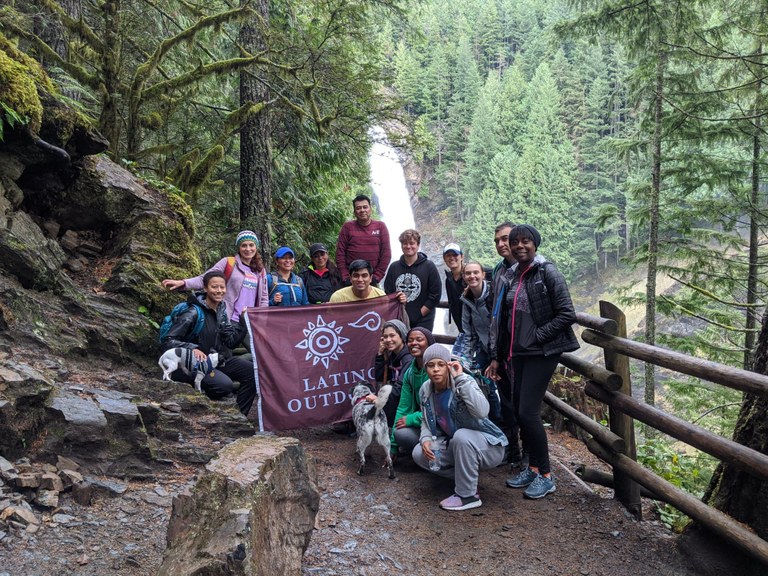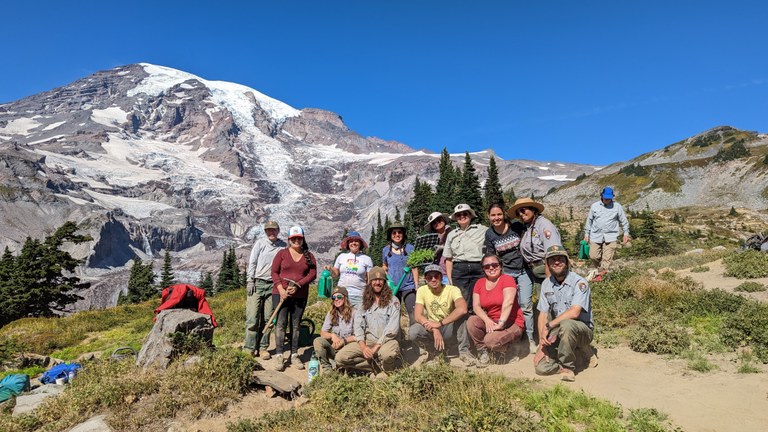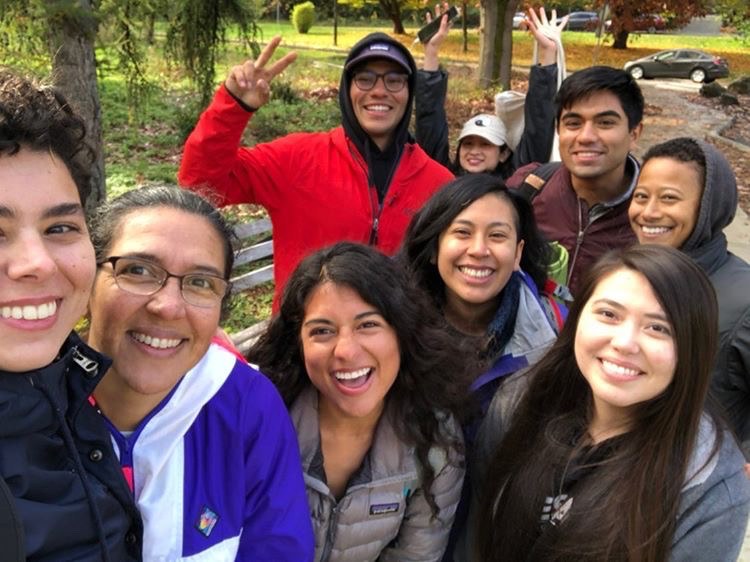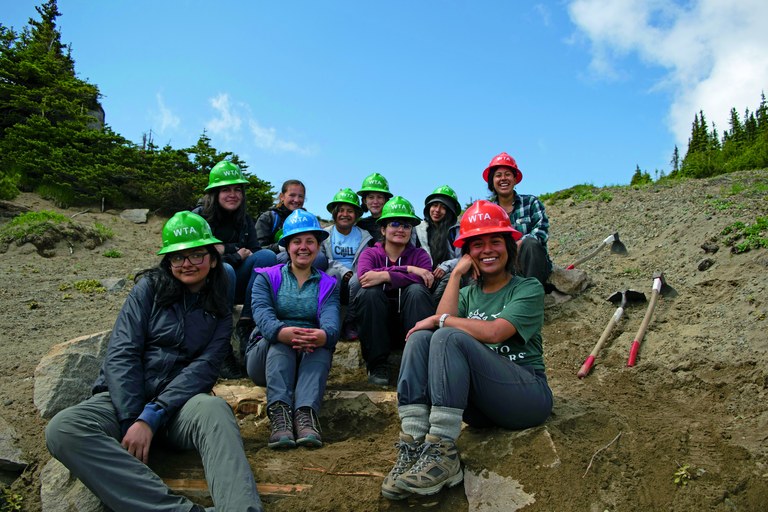 Washington Trails
Association
Washington Trails
Association
Trails for everyone, forever
Diversity is good for the people who love to get outside and for the natural world we care about. By Luis Villa
For a decade, Latino Outdoors has been part of a movement. In that time, the community of people who not only love and care for the outdoors, but also feel included in this community has blossomed into something more nuanced, more rich and more robust than what it once was.
As diversity and inclusivity in the outdoor community have steadily increased, they have added to broader social and environmental justice efforts. As a continuing contributor to these efforts, Latino Outdoors celebrated our 10th anniversary by eagerly looking towards the trail ahead and proudly looking back at the ground we have already covered.

Latino Outdoors volunteers in Seattle lead hikes to some of Washington's most beautiful trails. Photo by Allen Cárdenas
Latino Outdoors (LO) began as a one-person blog in 2013 and has flourished into a movement powered by a deeply committed network of volunteer outdoor enthusiasts and leaders. The LO network has served communities around the country through more than 1,000 outings for over 20,000 participants so far.
Latino Outdoors volunteers based in Seattle, for example, have collaborated multiple times with National Park Service staff at Mount Rainier to introduce community members to this iconic national park. During one of the more recent collaborations, participants built bonds between themselves and with the park through hiking, camping and stewardship. Seeing themselves reflected in the Latina park rangers with whom they worked to help revegetate a meadow made the experience that much more memorable.
From day hikes to dancing outside, biking to belaying, camping to caring for cempasúchil, mountaineering to mushroom foraging, the volunteers who lead LO outings have been connecting people to place and to each other for a decade through creativity, a sense of cultural pride and a passion for service.

Latino Outdoors volunteers based in Seattle have collaborated multiple times with National Park Service staff at Mount Rainier to introduce community members to this iconic national park. Photo courtesy Sully Moreno
To hear me or just about anyone else at LO tell it, you’d think we were convinced that spending time outdoors is a panacea for the challenges confronting us, individually and collectively. And although we are not oblivious to the tensions in our society, we believe we have a lot to gain from a community of outdoor enthusiasts that grows to become more representative of the diversity of people who actually comprise it.
We are all part of an increasingly interconnected global society, largely an outcome of the world’s dominant power and economic structures, which focus on profit and market share. But we can’t grow into new markets, and then not expect a response from or impact on the people and communities we’re selling to and extracting from.
When, for example, the outdoor industry uses its power to reach new audiences, that broader customer base will bring new ideas for experiencing the outdoors and for shaping the corresponding narrative. Similarly, those looking to grow the conservation community must understand that in doing so, the very definition of “conservation” will be put to the test, resulting in more nuance. The changes that follow can be uncomfortable.
There have been uncomfortable stretches during the first 10 years of Latino Outdoors. Those growing pains include being challenged to better represent the diversity within the Latino community itself. Actually, we do our best to refrain from referring to Latine communities in the singular in order to underscore the fact that they are far from monolithic.
LO started off as California-centric and with a particular Latino demographic. Time, along with constructive feedback from the communities we serve, helped change that. We still have more to do, but when looking at the LO comunidad today, we see more geographic, ethnic, racial, generational, political, professional and recreational diversity. This variety of thought, perspectives and lived experiences has compelled us to take pause, slow down, and, at times, look for an alternate route. We embrace the detours with the learning opportunities they offer.
Latino Outdoors relies on a framework for guiding our volunteers in crafting outdoor experiences. The framework’s four key words are people, place, process and policy. We encourage LO outings leaders to create experiences for people to connect to each other and to the place they are exploring. We also underscore the process of enjoying the outdoors safely and the policies that lead to protection for the places we enjoy.

Latino Outdoors outings don’t just connect people to nature — they also connect people with each other. Photo by Iris Zacharias
This open-ended guidance has led to mindfulness and watercoloring walks by volunteers like Victoria in California, summit hikes for Hispanic engineers by Nohemi in Colorado, birding beyond the city with Ariel and Juan in Illinois, outings in solidarity and community with groups like Black Women Who by Rosa Bianca, Azalia and Liz in Texas, and bike rides sweetened with Brazilian brigadeiros by Stephanie in Massachusetts. In creating outdoor experiences like these, LO volunteers are empowered to apply their own passion, perspective and personal touch.
The movement toward diversity in the outdoors is made up of many other affinity groups, including Black Women Who, Brown Girls Climb, Disabled Hikers, Hunters of Color, Outdoor Afro, Outdoor Asian, The Venture Out Project and Un Mar de Colores, to name just a few. And it is precisely this rich and robust diversity that makes the outdoor community stronger and more resilient. It’s not unlike an ecosystem that thrives thanks to rich biological diversity.

Organized recreation and stewardship outings offer opportunities for communities to get closer to nature and make an impact in the process. Photo by Iris Zacharias
Syren Nagakyrie, who founded Disabled Hikers, expresses the same idea when sharing the story of how they were inspired to start their organization.
“As a child, I spent hours outside, sitting under a tree or gazing at the moon. I noticed how different the plants and animals were from each other. This awareness helped me feel less isolated. I sensed that even though I was different from the other kids, I had a place in the world.”
Latino Outdoors has a place within a movement that celebrates diversity in the outdoor community. That movement is nested within society’s broader diversity, equity, inclusion and justice movement — DEIJ. Taking what I’ve learned on my own life’s trail from nature, people, experiences, and time, it’s dawned on me that that little acronym is actually a formula for societal and environmental success. It goes something like this: diversity + equity + inclusion = justice = peace + sustainability = a thriving world, and in that equation, diversity is the linchpin.
Luis Villa is the executive director of Latino Outdoors, which celebrated its 10th birthday in 2023. As part of the celebration, LO self-published a children’s book. The book follows Pepe Plantasemillas, a vibrant and colorful bird, on a journey to plant a magical seed of cultura y comunidad in different places while meeting new faces. Luis last crossed paths with Washington Trails Magazine readers in the fall of 2020, when he shared his thoughts and experience on how the conservation and social justice movements intersect.